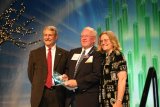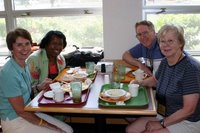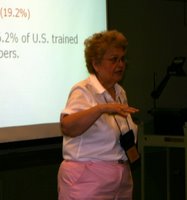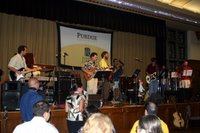“Discovery, Selection & Development of Drug Candidates: A Senior Leadership Perspective”
Presented by the Organic Topical Group of the
The speakers for this amazing and unique symposium were:
Dr. Carl P. Decicco, Bristol-Myers Squibb Co.: “Innovation in Drug Discovery”
Dr. Malcolm MacCoss, Merck & Co. Inc.: “Emend© (Aprepitant): a Potent, Orally Active Substance P Antagonist for the treatment of Chemotherapy Induced Nausea and Vomiting (CINV). From the Medicinal Chemistry Bench to the Clinic”
Dr. Paul L. Feldman, GlaxoSmithKline Inc.: “PPAR Pan Agonists – The Next Generation PPAR Ligands”
Dr. Bruce D. Roth, Pfizer: “The Discovery and Development of Lipitor”
The Keynote Speaker was Dr. P. Roy Vagelos, Retired Chairman and CEO Merck & Co. Inc.: “The Changing Pharmaceutical Industry”
The meeting was introduced and organized by Dr. Michael M. Miller the current NJACS Organic Topical Group Chair from Bristol-Myers Squibb.
Dr. Carl P. Decicco was the first speaker and he began his talk by discussing some data on creativity. A young child begins with very creative minds but as they grow up to adulthood this creativity is “educated” out of them by the need to conform to standard ways of thinking and learning. His premise was that creativity is what is needed by scientists in the drug discovery process and some scientists still have this knowledge. His talk included three drugs that Bristol-Myers Squibb has advanced recently within their pipeline. “Apixaban” is a new drug for deep vein thrombosis. The clinical data will be presented at the upcoming ASH meeting to be held in Orlando, FL in December so he was not at liberty to disclose that data at this meeting. It is a drug that prevents clot formation without unnecessary bleeding. Computer assisted drug design was used to find an inhibitor of the active site and the compound was furnished and tested. But this was not the only method used to find active compounds by the scientists at BMS, they used their creativity and empirical thinking to design and test other candidates.
Hepatitis B is caused by a virus which attacks the liver which can eventually cause cancer (another one of the cancers caused by a virus). The scientist put in five years of work to find a key compound by testing numerous analogues that were discovered during their medicinal chemistry program. Some of these compounds had been made by a multistep synthesis which involves much time and energy. They did a bio study of the lead compounds in woodchucks over three years to assure the efficacy of the compound. This study was needed to encourage the company that it was safe to move forward into the clinic.
The last drug he spoke about was Dastinib which is a second generation drug for Chronic Myeloid Leukemia (CML). This drug was featured in a Business Week article on smart drugs. CML represents 20% of the adult leukemia’s and can be controlled by targeting the Philadelphia Chromosome. Gleevec was the first breakthrough drug for CML but it has some severe side effects so BMS decided to continue and advance a program to prepare a therapeutic alternative for in this area of unmet medical need. Dasatinib was the result and is active in all phases of CML. This drug was made possible through creative thinking.
Dr. Malcolm MacCoss detailed the history of the discovery of EMEND which is a Substance P antagonist for the treatment of chemotherapy induced nausea and vomiting. This involved a long term research project until the final compound was found. During this research project one of the biochemists on the projects was diagnosed with breast cancer. She had so much trouble during her first session of chemotherapy that she was not going to undergo it again. She asked to be able to use EMEND during the early clinical phase of the drug under “compassionate use.” This drug enabled her to undergo her last chemotherapy without a problem. This story was used to exemplify that at Merck “patients come first!”
Dr. Paul Feldman spoke about PPAR Pan Agonists. This class of compounds are involved in metabolic syndrome which involves obesity, hypertension, cardiovascular disease and diabetes. About 25% of the public has metabolic syndrome. Obesity is a growing problem as even teenagers are becoming obese at an early age. Currently the FDA does not recognize it as a disease. The scientist identified the PPAR ligand and then tested 5,000 molecules to find the one which would interact with the receptor. The GSK chemists enhanced the target molecule through medicinal chemistry techniques. It was remarked that efforts like this one needs to be done because patients are waiting for new compounds to counteract obesity and other areas of metabolic syndrome.
Dr. Bruce Roth is the single patent holder for Lipitor. He entertained the audience with the story of the discovery and development of Lipitor by the research and development teams at Pfizer. The discovery of Lipitor is an amazing story of innovation and perseverance, as well as risk on the part of the pharmaceutical industry to advance a compound in a medical landscape congested with a large amount of competition.
After dinner Dr. P. Roy Vagelos gave the keynote address. He was introduced by Dr. Malcolm MacCoss, VP of Basic Chemistry and Drug Discovery Sciences of Merck,
Dr. Vagelos gave an overview of his time at Merck and the Pharmaceutical Industry in general. Dr. Vagelos was a researcher who brought his interest in research to Merck. He said that he had fun at Merck because of the “drug discovery process.” When he was CEO of the company, the organization was at its heyday and the industry was held in high respect. In 2004 there was a Harris Poll about the Pharmaceutical Industry. People had lost confidence in the industry because of the high prices and because they did not respond to the needs of people in the developing countries.
The problem of pricing has to do with the long time that the discovery and development process takes. For example the precursors to the drug Mevacore was discovered in 1978 but was not launched until 1987. The second generation drug Zocor took 5.5 years from discovery to launch. This is one of the reasons for the high prices of drugs, it accounts for the enormous cost poured into R&D each year to address unmet medical needs of the public’s interest.
With respect for improving the health of people in the third world, Dr. Vagelos was responsible for the donation of Metizin for the prevention of River blindness to the developing countries. When scientist William Campbell discovered a compound that was active to prevent the disease, it was decided that it should be donated to the people who would need it. A new drug application was filed in
He then talked about the three drug cocktail for AIDS. It costs about $25,000 a year for the treatment of people with AIDS which transform the disease from a lethal disease to a chronic disease. It was known that this disease was endemic in
He spoke briefly about VIOX by saying all drugs (including aspirin) have side effects. They are tested in limited populations for a limited time. When a side effect is discovered during use within a patient pool, the company should tell the FDA and then change the label describing the side effect, but not take it off the market.
He said that big pharma is no longer a growth industry because many drugs are going off patent. The new growth will come from small companies which start with zero sales. These companies are started by professors who recruit their best students to work for them. Many of these companies fail but the chemists are able to go from company to company for new employment.
He said currently, big pharma can be considered mature companies. They are:
- Outsourcing the discovery process
- The development process is done in-house
- Early in the clinical research process they are genotyping people to discover the eventual side effects.
- Outsourcing manufacturing
- Sales and marketing should be changed. Sales representatives waste a lot of time trying to see doctors. Three academic medical schools have banned sales reps. Companies need to find new ways to get the information to doctors.
- Direct advertising to the consumer puts a great demand for the drugs to the doctors. He feels they should limit the direct advertising until there has been a lot of human exposure to the new drugs.
He summed it up by saying that the pharmaceutical industry affects the lives of all people in a positive way. It is through the efforts of the thousands of scientists that tirelessly work to find cures of disease that life saving new drugs are found and dispersed to society.







